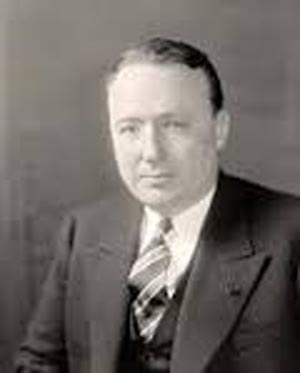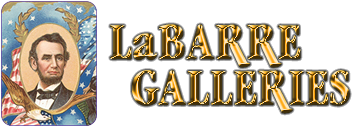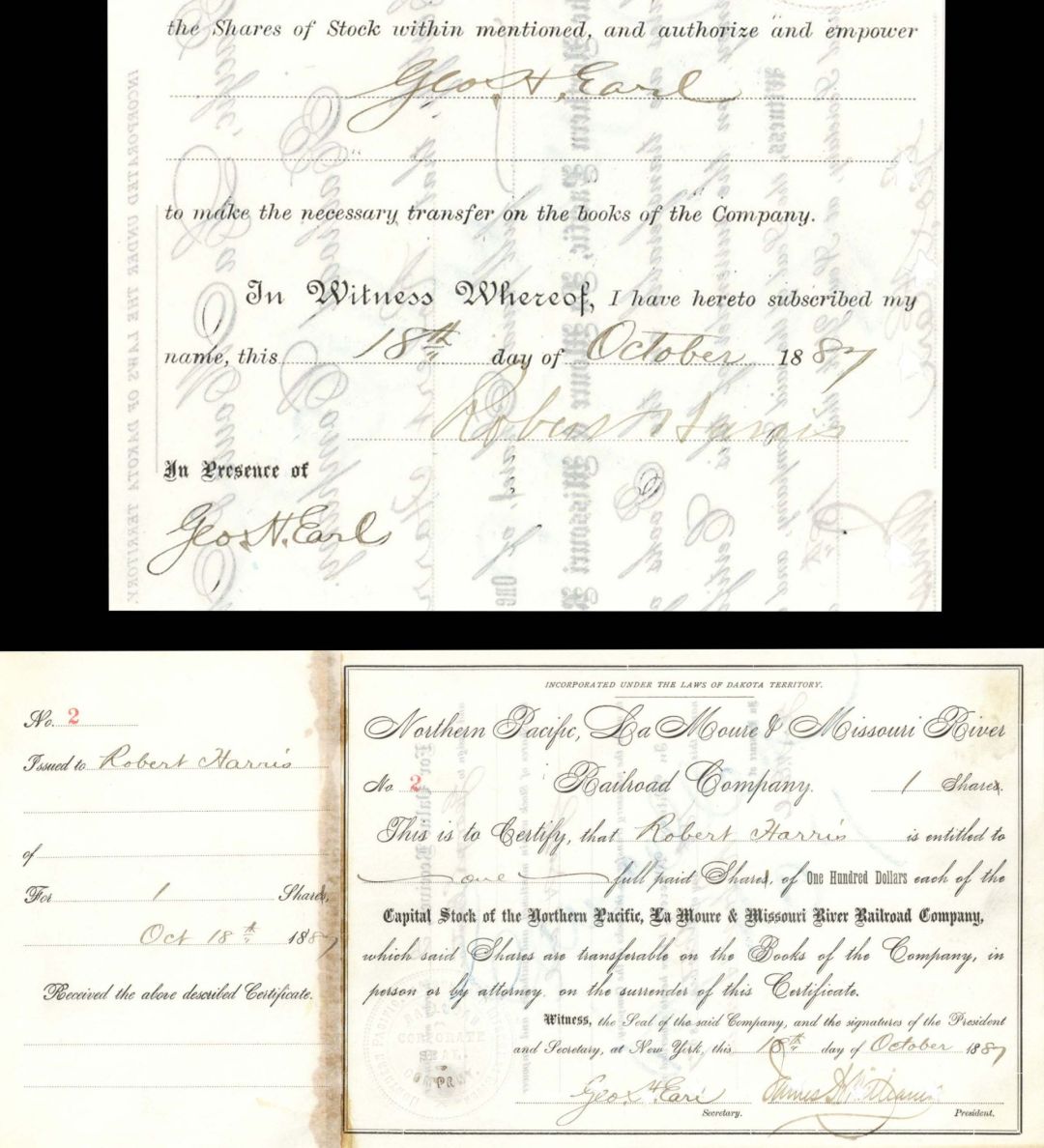Northern Pacific, La Moure and Missouri River Railroad Co. issued to and signed by Robert Harris and Geo. H. Earl - 1887 dated Autographed Stock Certificate
Inv# AG2116 AutographStock issued to and signed by Robert Harris on the back. Signed three times by Geo. H. Earl on front and back. Certificate #2!

Robert Harris (July 29, 1830 – April 21, 1894) was a civil engineer and railroad executive who became president of the Chicago, Burlington and Quincy Railroad and Northern Pacific Railway. Robert Harris was born on July 29, 1830, in Portsmouth, New Hampshire. His father was educator William Coffin Harris (born 1767) and mother was Mary Johnson. His brother Charles Coffin Harris (1822–1881) became the Chief Justice of the Supreme Court of the Kingdom of Hawaii. He studied civil engineering in Boston, and briefly studied law like his older brother. In 1852 Harris became assistant engineer for the Hartford, Providence and Fishkill Railroad (later the New York and New England Railroad). In April 1853 he moved to Wisconsin and was resident engineer for Beloit and Madison Railroad (later the Chicago and North Western Railway). From April 1856 to February 1860 he was superintendent of the Racine and Mississippi Railroad (later part of the Milwaukee Road system). In April 1860 he moved to Texas to become superintendent of the Galveston, Houston and Henderson Railroad. From November 1860 to June 1861 he was superintendent of the Buffalo Bayou, Brazos and Colorado Railway. During the American Civil War he worked for the Quartermaster's department of the Union Army in North Carolina. In July 1863 he became assistant general superintendent of the Chicago, Burlington and Quincy Railroad (CBQ) where he would work for 15 years. In May 1865 he became general superintendent, and in February 1876 he became president of CBQ until June 1878. In October 1878 he became general manager of the New York, Lake Erie and Western Railroad (NY&E). In December 1880 he became vice-president of NY&E until January 1884. On October 15, 1879, he had become a director of the Northern Pacific Railway (NP). Although offered the position of vice-president in 1881, he declined, and Thomas Fletcher Oakes took that position. After Henry Villard stepped down, he became president of NP in January 1884. In October 1888 he resigned, Oakes became president, and Harris Chairman of the Board. In 1893 he was re-elected to the board and named vice-president. He died April 21, 1894 in Rochester, New York, on his way back from a business meeting.

George Howard Earle Sr. (1823-1907) Mr. Earle was of old New England Quaker stock, and he was the seventh in descent from Captain Ralph Earle, of Portsmouth, R. I. His parents were Thomas Earle and Mary Hussey, and they came to this city from Massachusetts immediately after their marriage. The son was born here on December 8, 1823.
George H. Earle received most of his education in the schools of this city. He attended a private school in Massachusetts for one year. In accordance with the practice obtaining among the Friends at that time, he was apprenticed to Matthias Baldwin, founder of the locomotive works, and served for a time in his shop.
When he reached the legal age, he decided to study law. After his admission to the Bar he spent the year 1848 in a pedestrian tour through Europe. It was an eventful journey. Owing to the political disturbances which were agitating Europe at that time, he was frequently suspected of being a spy. In Vienna, Rome, Naples, Munich and Paris he saw conflicts in the streets between citizens and soldiers. In Paris he narrowly escaped being killed.
After the year of travel he returned to this city and opened a law office in partnership with Richard P. White, his brother-in-law. Thomas Earle died the same year, and the son fell heir to his father's large practice. About that time he married Ellen Frances von Lohr, the wedding taking place on April 5, 1849.
For nearly fifty years the law firm of Earle & White enjoyed a lucrative and an extensive practice. George H. Earle soon began to assert himself as a champion of the slave and also as a municipal reformer. As a boy he had taken part in an anti-slavery demonstration, and he was wounded at the riot attending the burning of Pennsylvania Hall.
He defended many slaves captured under the provisions of the Fugitive Slave law, and on more than one occasion obtained the release of his clients. He was a delegate to the first Republican National Convention, in 1856, which nominated John C. Fremont for the Presidency. Until his death he was the oldest living delegate to that convention. He took the stump and took part in the campaigns which preceded the election of Lincoln and Grant.
After the Civil War he turned his attention to municipal affairs. As a result of the political abuses of that day the debt of the city was almost $70,000,000. He led in the movement to have the city's affairs conducted on a business basis, and he was one of the organizers of the taxpayers' association for municipal reform, of which Henry C. Lea was chairman. This association was succeeded by the Committee of One Hundred. Mr. Earle took an equally active part in the work of the committee, and as chairman of the Committee on Public Meetings he arranged all the notable gatherings. At these meetings Mr. Earle was himself a speaker. His manner was simple yet powerful, and when he desired to be, he was deliciously satirical. He kept up the fight for municipal regeneration until the adoption of the Bullitt Bill, and since that time he had kept in close touch with public affairs, although not being an active participant.
The noted Abolitionist was an intimate friend of Abraham Lincoln. In fact, there were few great men in the country's history for the past fifty years with whom he did not have close acquaintance."











Ebay ID: labarre_galleries